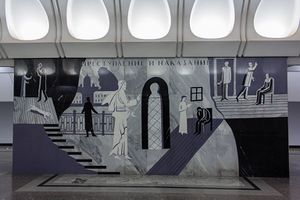Dostoevsky on the Moscow Metro

In June of 2010, a new metro station appeared on the Grey line in Moscow themed around the famous Russian author Fyodor Dostoevsky and his works (Osborn). Although many of his novels, such as Crime and Punishment, The Idiot, and The Double occur in the western city of St. Petersburg, it cannot be forgotten that the famous Russian author was born and spent his childhood in Russia’s capital city (Yarmolinsky). The station, called Dostoevskaya or Достоевская in Russian, features several murals by Russian artist Ivan Nikolaev, depicting scenes from various works by Dostoevsky, including Crime and Punishment, The Idiot, and Demons. As anyone familiar with Dostoevsky’s writing could imagine, the murals stirred up controversy when the station first opened, with concerns varying from the unpleasant nature of depictions, to fears that this station would turn into a “suicide mecca” for troubled Muscovites (Osborn n.p.).
Upon entering the station, one walks down a series of steps alongside two silhouetted figures drawn on the marble walls, rushing just as you are to catch the next train. Once reaching the bottom of these stairs one enters a long corridor with a large marble mural of the Russian author offering an ominous welcome to the Moscow underground. After another escalator ride down to the train platform, one can explore the various murals depicting the imagined world of the station’s namesake. One of the more memorable murals depicting Crime and Punishment (Преступаение и Наказание in Russian) depicts a number of scenes from the novel, including Sonya’s reading of the tale of Lazarus and Raskolnikov’s murder of two women by axe. In an article by NPR, the artist Nikolaev says his task was, “to draw out the meaning, creativity, and entire life of Dostoevsky” (Greene).
As previously mentioned though, after the station’s opening there were many who criticized the appropriateness of Dostoevsky’s images and ideas on a subway platform. In the same NPR article, David Greene explores some of the negative sides of these images of death and suicide entering a public place. Discussing Mikhail Vinogradov, the head of a Moscow Psychological Help Centre who went on television shortly after the opening of the station and criticized the artwork, Greene balances the opposing sides of criticism. Greene writes, “Like other psychologists who raised concerns in Russia and abroad, Vinogradov says gripping images can induce violent behavior — and a subway station is the last place for that… But Natalia Semyonova, another clinical psychologist in Moscow, defended the artist and the author, whose books she uses in lectures and to treat patients…Using powerful literature to help overcome challenges in one's own life, she says, is very Russian” (n.p.). Surrounded by this controversy in early 2010, the Moscow metro did delay the opening of the station several months ahead to June. However, to this day no suicides or axe-wielding murders have taken place in or around the station.
Works Cited:
Greene, David. “A Dark View of Dostoevsky on the Moscow Subway.” NPR. 9 August 2010. http://www.npr.org/templates/story/story.php?storyId=128954859. Osborn, Andrew. “Moscow’s Dostoevsky Station Could be a ‘Suicide Mecca’.” The Telegraph. 21 June 2010. http://www.telegraph.co.uk/news/worldnews/europe/russia/7843557/Moscows-Dostoevsky-station-could-be-suicide-mecca.html. Sorokin, Valery. “Станция метро "Достоевская". Москва. "Crime and Punishment". Dostoevskaya Moscow Metro Station” Panoramio. 20 January 2013. http://www.panoramio.com/photo/84959397. Yarmolinsky, Avrahm. Dostoevsky: Works and Days. Funk & Wagnals, 1971.